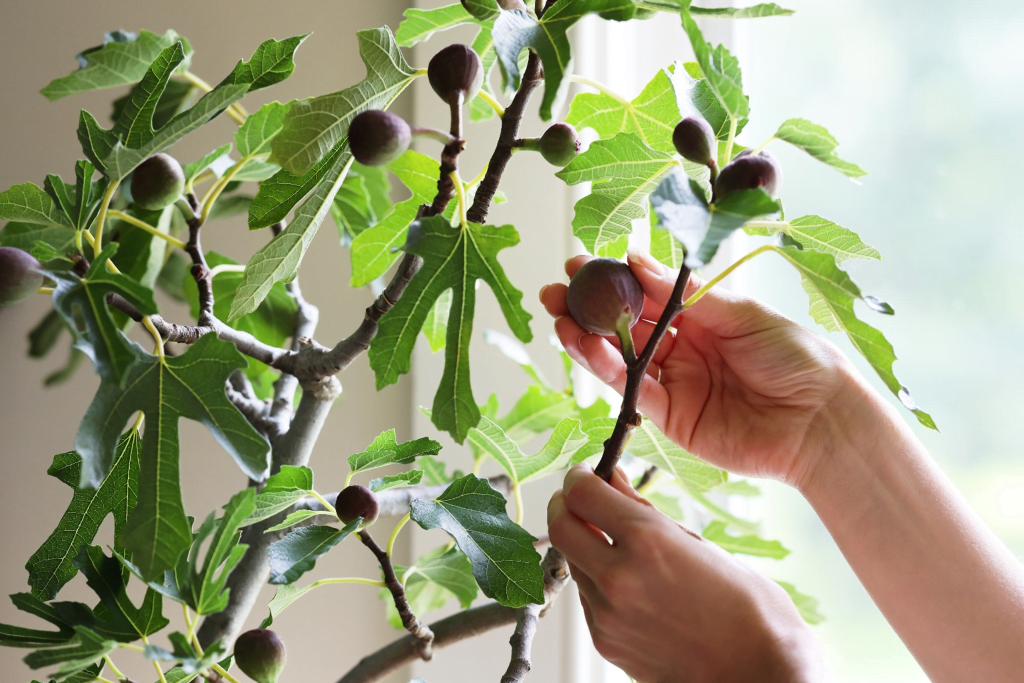A fig tree is more than just a garden plant. It’s a source of beauty, yummy fruit, and a connection to history. A practical connection to nature with its own sweet indulgence? Yes, please. Cultivating fig trees is rewarding, whether you’re an avid gardener or just starting out. Figs not only add a boost to your culinary dishes, but the tree’s characteristics are a gorgeous addition to your home decor, outdoor landscaping, and lifestyle. Read on to learn how to make the most of this slice of Mediterranean heaven.
DIVINE SCENT & FRUITING TIPS
This fruit-producing tree is native to Mediterranean climates, with smooth white bark, large leaves, and crisp honey-like scents. Syrupy fruit, sweet floral notes, and sandalwood to evoke the Mediterranean all wrap up in the fragrance of these trees. You can smell them coming. See for yourself!
LIGHT & WATER
Figs love the full sun (Siri, play, “Here Comes the Sun!”) so choose a location in your garden or home that receives 7-8 hours of sunlight daily.
Once established, figs are very drought-tolerant. So, be sure to avoid waterlogging! Deep watering once a week is generally sufficient for dry climates. Adjust based on your local conditions.
THE RIGHT SOIL MATTERS
Well-drained, fertile soil is essential for healthy fig trees. They prefer slightly alkaline soil but can adapt to a range of soil types.
Pruning: In late winter, check on your figs! Give your fig tree a little TLC by removing dead or weak branches to encourage new growth, and better fruit production overall.
Fertilization: Picture this: it’s early spring, the birds are chirping, the blooms are just starting to sprout. Now is the perfect time to treat your fig tree with a balanced, slow-release fertilizer. Best to do this before new growth begins.
Protect from the cold: If you live in a colder climate, consider wrapping your fig tree with burlap or providing it with some form of winter protection, if you prefer it outside.
Tip: Brown spots (rust) may occur when it’s planted or kept outside. Rest assured that it doesn’t affect the plant –it’s more of a cosmetic issue caused by a fungus that occurs when the leaves stay wet. Use a copper fungicide to help this!
ANCIENT ORIGINS
Fig trees are kind of a big deal, not only in their delicious and elegant nature, but for how long they have been around. Fig trees have been cultivated for thousands of years and are among the oldest crops, believed to have originated in the Middle East and Mediterranean regions.
POLLINATION MUTUALISM
Figs have a fascinating method of pollination – instead of relying on bees, they are pollinated by a tiny wasp called the fig wasp. The relationship between figs and fig wasps is a remarkable example of mutualism.
MULTIPLE HARVESTS
Fig trees can produce two distinct crops in a year. The first crop, called the breba crop, occurs in early summer on last year’s growth. The main crop follows later in the summer or early fall on the current year’s growth.
RICH IN NUTRIENTS
Figs are not only delicious but very nutritious. They are a good source of dietary fiber, vitamins, and minerals. Figs are also known for their natural sweetness, making them a healthier alternative to processed sugars (even honey!)
Enjoy the fresh, flavorful fruit it produces. Homegrown figs have a sweetness and juiciness that store-bought figs often lack.
Another benefit? Fig trees are as aesthetically pleasing as they are functional. Their large, lobed leaves and twisting branches add elegance to your home & garden.
Caring for a fig tree is a delightful and fruitful experience. By following proper care tips and taking advantage of their many benefits, you can enjoy the beauty of a fig tree in your garden while relishing the delicious rewards. Whether you’re a seasoned gardener or a novice, consider adding a fig tree to your outdoor space and savor the sweetness.
Get figgy with it!
The Sun Grove Care Team
Want more? Follow us on Instagram for daily tips or shoot us an email at hello@sungrove.com with specific questions.

